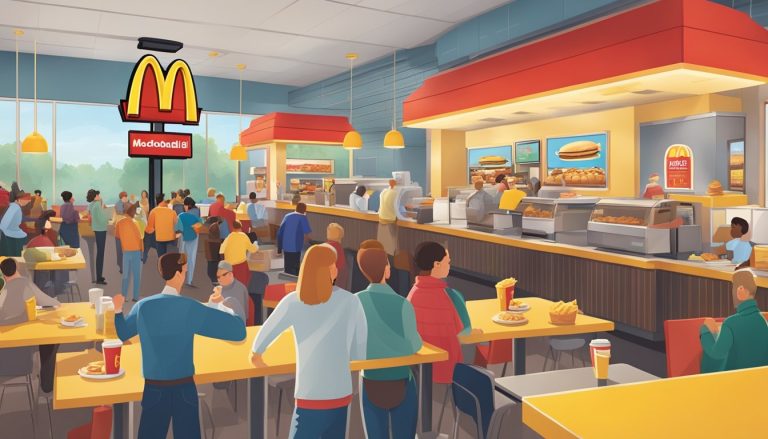McDonald’s breakfast menu has long been a staple for many early risers and weekend brunch enthusiasts. The fast food giant has introduced numerous morning offerings over the years, aiming to satisfy diverse tastes and preferences. However, not every item has stood the test of time.
While some breakfast items have become iconic, others failed to capture customers’ hearts and taste buds. This article explores 13 McDonald’s breakfast menu items that didn’t quite make the cut. From ambitious creations to regional specialties, these discontinued offerings provide insight into the company’s culinary experiments and changing consumer preferences.
1) McGriddle Royale

The McGriddle Royale was McDonald’s attempt to add a touch of elegance to their breakfast menu. Introduced in select markets in 2023, this sandwich combined elements of the classic McGriddle with premium ingredients.
The McGriddle Royale featured a maple-infused griddle cake, a thick slice of Canadian bacon, a fluffy egg patty, and melted Swiss cheese. To elevate the flavor profile, it was topped with a creamy hollandaise sauce.
Despite its promising concept, the McGriddle Royale failed to gain traction among customers. Many found the combination of sweet griddle cakes and rich hollandaise sauce too decadent for breakfast.
The higher price point compared to other breakfast items also deterred budget-conscious consumers. McDonald’s struggled to justify the cost increase for what essentially remained a breakfast sandwich.
After a brief trial period, McDonald’s quietly removed the McGriddle Royale from their menu. The item’s failure demonstrated the challenges of introducing upscale offerings in a fast-food breakfast setting.
2) Egg White Delight McMuffin

McDonald’s introduced the Egg White Delight McMuffin in 2013 as a healthier alternative to their classic breakfast sandwich. The new item featured egg whites, extra lean Canadian bacon, and white cheddar cheese on a whole grain muffin.
The Egg White Delight McMuffin was part of McDonald’s efforts to appeal to more health-conscious customers. It contained fewer calories and less fat than the traditional Egg McMuffin.
Despite initial excitement, the Egg White Delight McMuffin failed to gain long-term popularity. According to a former McDonald’s chef, the item did not meet the company’s sales expectations.
The sandwich quietly disappeared from menus without much fanfare. Many customers didn’t even notice its absence, suggesting it never gained a strong following.
The discontinuation of the Egg White Delight McMuffin demonstrates the challenges fast food chains face when introducing healthier options. While some customers appreciate these choices, they often struggle to compete with more indulgent menu items in terms of sales.
3) McDonald’s Cinnamon Melt
McDonald’s Cinnamon Melts were introduced in 2007 as part of the breakfast menu. These sweet treats offered a unique twist on the classic cinnamon roll, presenting a more portable format for on-the-go customers.
The Cinnamon Melts consisted of small pieces of dough baked together with a gooey mixture of butter, brown sugar, and cinnamon. They were topped with a generous drizzle of cream cheese icing, creating a delightful combination of flavors and textures.
Despite their initial popularity, especially among those with a sweet tooth, Cinnamon Melts were eventually removed from the menu. The exact date of their discontinuation is unclear, but their absence has been noted by many McDonald’s fans.
The removal of Cinnamon Melts from the menu left a gap in McDonald’s sweet breakfast offerings. While the chain has introduced other pastry items over the years, many customers still fondly remember the unique appeal of the Cinnamon Melts.
4) Brunch Burger Breakfast Sandwich

The Brunch Burger Breakfast Sandwich was a short-lived McDonald’s menu item that attempted to bridge the gap between breakfast and lunch offerings. This unique creation combined elements from both meal periods into one hefty sandwich.
The Brunch Burger featured two beef patties, cheese, bacon, a hash brown patty, and scrambled eggs, all nestled between a sesame seed bun. It aimed to satisfy customers craving both breakfast and lunch options simultaneously.
Despite its innovative concept, the Brunch Burger failed to gain traction with McDonald’s customers. The sandwich was only available during a brief window around 10:35 AM, when the restaurant transitioned from breakfast to lunch service.
Many customers found the combination of ingredients overwhelming and difficult to eat. The mix of flavors and textures proved too complex for some palates, leading to lackluster sales and eventual discontinuation.
The Brunch Burger’s failure highlighted the challenges of creating successful hybrid menu items. It demonstrated that while customers enjoy breakfast and lunch separately, combining them doesn’t always result in a winning product.
5) Scrambled Eggs with Chorizo

McDonald’s introduced Scrambled Eggs with Chorizo in select markets as a limited-time offering. This breakfast item aimed to cater to customers seeking a spicier morning option.
The dish featured McDonald’s signature scrambled eggs mixed with chorizo, a type of spicy pork sausage popular in Spanish and Mexican cuisine. It was typically served on a platter or in a breakfast burrito.
Despite initial excitement from some customers, Scrambled Eggs with Chorizo failed to gain widespread popularity. Many found the flavor profile too bold for their breakfast preferences.
Some customers reported that the chorizo overpowered the eggs, creating an imbalance in taste. Others felt the spice level was inconsistent across different locations.
The item’s limited availability and regional focus contributed to its lack of success. It never achieved the national recognition needed to become a permanent menu staple.
McDonald’s eventually discontinued Scrambled Eggs with Chorizo, focusing instead on more traditional breakfast offerings that appealed to a broader customer base.
6) Fruit & Walnut Salad
McDonald’s introduced the Fruit & Walnut Salad in 2005 as part of its healthier menu options. The salad consisted of sliced apples, red grapes, candied walnuts, and a small container of low-fat vanilla yogurt.
Initially, the Fruit & Walnut Salad gained popularity among health-conscious customers. It offered a lighter alternative to traditional breakfast items and appealed to those seeking fresh fruit options.
Despite its initial success, the salad faced challenges. Some customers found the portion size too small for the price. Others complained about the quality and freshness of the fruit, which varied between locations.
The salad also had a relatively short shelf life compared to other menu items. This led to increased food waste and operational difficulties for franchisees.
By 2013, McDonald’s quietly removed the Fruit & Walnut Salad from its menu. The item’s discontinuation reflected changing consumer preferences and the company’s shift towards simplifying its menu offerings.
7) Mighty Wings
Mighty Wings made their debut on McDonald’s menu in 1990 as a new chicken offering. These bone-in chicken wings were intended to diversify the chain’s menu and attract more customers.
Despite initial excitement, Mighty Wings failed to gain traction with consumers. The product struggled with several key issues that ultimately led to its downfall.
Price was a significant factor in the wings’ lack of success. Mighty Wings were positioned as a premium item, with a 3-piece pack costing $3.69 and a 10-piece pack priced at $9.69.
Taste and appearance also played a role in the product’s failure. Some customers found the wings’ flavor unsatisfactory, while others felt their presentation was not appetizing enough.
McDonald’s attempted to revive Mighty Wings in 2013, but the relaunch faced similar challenges. The product lasted only about a year before being discontinued again.
The failure of Mighty Wings serves as an example of how even established fast-food chains can struggle when introducing new menu items that don’t align with customer expectations or preferences.
8) McPasta

In the early 1990s, McDonald’s ventured into the world of Italian cuisine with McPasta. This unusual menu item was an attempt to diversify the fast-food giant’s offerings and appeal to customers seeking more variety.
McPasta came in three flavors: spaghetti, fettuccine alfredo, and lasagna. The dishes were served in microwaveable containers, allowing for quick preparation in McDonald’s kitchens.
Despite the novelty factor, McPasta failed to gain traction with customers. Many found the concept of pasta from a fast-food restaurant unappealing, preferring traditional Italian eateries for such dishes.
The preparation time for McPasta also posed a challenge. It took longer to cook than typical McDonald’s fare, causing delays and disrupting the restaurant’s fast-paced service model.
After a brief trial period, McDonald’s quietly removed McPasta from its menu. The experiment demonstrated the challenges of introducing non-traditional items to a well-established fast-food menu.
9) McDonald’s Bagels
McDonald’s introduced bagels to its breakfast menu in the late 1990s. The bagel sandwiches quickly gained popularity among customers seeking a heartier morning option.
Despite initial success, McDonald’s made the decision to remove bagels from its menu in 2020. This move was part of a larger effort to streamline operations and simplify the breakfast menu during the COVID-19 pandemic.
The departure of bagels from McDonald’s left many fans disappointed. The chain had offered various bagel sandwiches, including options with bacon, egg, and cheese.
In 2023, McDonald’s brought bagels back to select locations. However, the return was limited and not implemented nationwide. This partial reintroduction indicates that bagels may not have been as successful as other breakfast items.
The inconsistent availability of bagels at McDonald’s has led to confusion among customers. Some locations offer them, while others do not, making bagels a somewhat elusive menu item.
While bagels have a dedicated following, their on-again, off-again status at McDonald’s suggests they may not have met the chain’s expectations for widespread, long-term success.
10) McPlant Breakfast Sandwich

McDonald’s introduced the McPlant Breakfast Sandwich in an attempt to cater to the growing plant-based food market. This menu item featured a plant-based patty made from pea protein, paired with a folded egg and cheese on an English muffin.
Despite the initial buzz surrounding its launch, the McPlant Breakfast Sandwich failed to gain traction among customers. Many consumers found the taste and texture of the plant-based patty lacking compared to traditional meat options.
The sandwich also faced criticism for its high calorie and sodium content, which contradicted the health-conscious image associated with plant-based alternatives. This discrepancy led to disappointment among health-focused customers seeking lighter breakfast options.
McDonald’s eventually discontinued the McPlant Breakfast Sandwich due to low sales and lackluster customer reception. The company’s attempt to enter the plant-based breakfast market proved premature, as consumer preferences for traditional breakfast fare remained strong.
The failure of the McPlant Breakfast Sandwich highlighted the challenges fast-food chains face when introducing plant-based options to their breakfast menus. It demonstrated the importance of balancing innovation with customer expectations and taste preferences.
11) Southern Style Chicken Biscuit

The Southern Style Chicken Biscuit was a breakfast menu item at McDonald’s that aimed to capture the essence of Southern cuisine. It featured a crispy chicken patty served on a freshly baked biscuit.
This sandwich contained 410 calories, with 180 of those coming from fat. The total fat content was 20 grams, including 8 grams of saturated fat.
Despite its attempt to appeal to Southern taste preferences, the Southern Style Chicken Biscuit failed to gain widespread popularity. It was eventually discontinued from most McDonald’s locations.
The sandwich faced competition from similar offerings at other fast food chains that specialized in Southern-style cuisine. Some customers found the flavor profile lacking compared to more authentic Southern chicken biscuits.
While it didn’t succeed nationally, the Southern Style Chicken Biscuit did maintain a fan base in certain regions. Its removal from the menu disappointed some loyal customers who appreciated its unique take on a classic Southern breakfast item.
12) Mashed Potato Burger

McDonald’s Mashed Potato Burger was an unconventional breakfast item that failed to gain traction with customers. This unique creation combined a beef patty with a generous dollop of mashed potatoes, all sandwiched between two buns.
The concept aimed to merge comfort food with fast-food convenience. McDonald’s hoped to appeal to those seeking a heartier breakfast option that strayed from traditional menu items.
Despite its innovative approach, the Mashed Potato Burger faced several challenges. Many customers found the combination of mashed potatoes and a burger patty too heavy for breakfast. The texture contrast between the soft potatoes and the meat also proved unappealing to some.
The item’s limited test run in select markets revealed lackluster sales. Feedback indicated that while some appreciated the novelty, most preferred more conventional breakfast choices.
McDonald’s ultimately decided to discontinue the Mashed Potato Burger. This decision aligned with the company’s strategy of focusing on popular, tried-and-true breakfast offerings that consistently perform well across various demographics.
13) Hulaburger

The Hulaburger stands out as one of McDonald’s earliest menu flops. Introduced in the 1960s, this meatless sandwich was created to appeal to Catholic customers who abstained from meat on Fridays.
Ray Kroc, McDonald’s franchise owner, came up with the unique idea. The Hulaburger consisted of a grilled pineapple slice and cheese sandwiched between two buns.
Despite its innovative approach, the Hulaburger failed to gain traction with customers. In a head-to-head sales competition with the Filet-O-Fish, it performed dismally.
Reports indicate that on the test day, only six Hulaburgers were sold compared to 350 Filet-O-Fish sandwiches. This poor performance sealed the Hulaburger’s fate.
The Filet-O-Fish went on to become a permanent menu item, while the Hulaburger was quickly discontinued. This early failure demonstrates the challenges of introducing unconventional items to fast-food menus.
History of McDonald’s Breakfast Menu

McDonald’s breakfast menu has a rich history dating back to the early 1970s. The fast food giant pioneered quick breakfast offerings, revolutionizing morning dining habits for millions of customers.
In 1972, McDonald’s introduced the Egg McMuffin, created by franchisee Herb Peterson. This innovative sandwich became an instant hit and laid the foundation for the company’s breakfast success.
By 1977, McDonald’s officially launched its national breakfast menu across the United States. The initial lineup included:
- Egg McMuffin
- Hotcakes
- Toasted English muffin
- Scrambled eggs
- Sausage
- Hash browns
- Danish
Over the years, McDonald’s continued to expand its breakfast offerings. New items were added to cater to changing consumer tastes and preferences.
In 1986, McDonald’s made another significant move by extending its breakfast hours. This decision allowed more customers to enjoy their morning favorites, further solidifying the chain’s position in the breakfast market.
The popularity of McDonald’s breakfast menu sparked competition among other fast food chains. This led to what became known as the “Breakfast Wars” in the industry.
McDonald’s has consistently innovated its breakfast menu, introducing items like the McGriddles in the early 2000s. The company also experimented with offering breakfast items throughout the day, responding to customer demand.
Consumer Preferences and Trends
McDonald’s breakfast menu has evolved significantly in response to shifting consumer tastes and health concerns. The fast-food giant has adapted its offerings to meet changing customer demands and market trends.
Changing Tastes Over Time
McDonald’s has witnessed a shift in breakfast preferences over the years. Traditional items like pancakes and sausage have faced competition from more portable options. Customers now favor grab-and-go items that fit their busy lifestyles.
The rise of coffee culture has also influenced McDonald’s breakfast menu. The company expanded its beverage offerings to include specialty coffee drinks, catering to consumers seeking more sophisticated options.
Regional tastes have played a role in menu development. McDonald’s has introduced localized breakfast items in different markets to appeal to diverse palates.
Health and Dietary Concerns
Health-conscious consumers have prompted McDonald’s to rethink its breakfast offerings. The company has added healthier options to its menu, including fruit and yogurt parfaits and oatmeal.
Calorie counts and nutritional information are now prominently displayed, allowing customers to make informed choices. This transparency has become increasingly important to health-aware patrons.
Dietary restrictions have also shaped the menu. McDonald’s has introduced gluten-free and vegetarian breakfast options to cater to customers with specific dietary needs.
The company has made efforts to reduce artificial ingredients and preservatives in its breakfast items, responding to the growing demand for more natural food options.
Lessons Learned from Unsuccessful Items
McDonald’s has gained valuable insights from its breakfast menu failures. These lessons have shaped the company’s approach to product development and customer engagement.
Market Research and Development
McDonald’s learned the importance of thorough market research before launching new breakfast items. Failed products often resulted from misalignment with consumer preferences or cultural tastes. The company now conducts extensive testing and regional trials before nationwide rollouts.
Timing and trends play a crucial role in product success. McDonald’s realized that some items were introduced too early or too late to capture market interest. This led to a more strategic approach in identifying and capitalizing on emerging food trends.
The fast-food giant also recognized the need for operational simplicity. Complex breakfast items that slowed down service or required specialized equipment proved unsustainable. This prompted a focus on menu items that balance innovation with practical preparation methods.
Consumer Feedback Integration
McDonald’s discovered the value of actively soliciting and incorporating customer feedback. Failed breakfast items often lacked the input of the target audience during development stages. The company now employs various methods to gather consumer opinions, including surveys, focus groups, and social media monitoring.
Flexibility in adapting to customer preferences became a key strategy. McDonald’s learned to quickly modify or remove underperforming items based on real-time feedback. This approach helps maintain menu relevance and customer satisfaction.
The importance of clear communication about new breakfast offerings became evident. Some items failed due to insufficient marketing or unclear positioning. McDonald’s now emphasizes effective promotional strategies to educate customers about new menu additions and their unique selling points.




